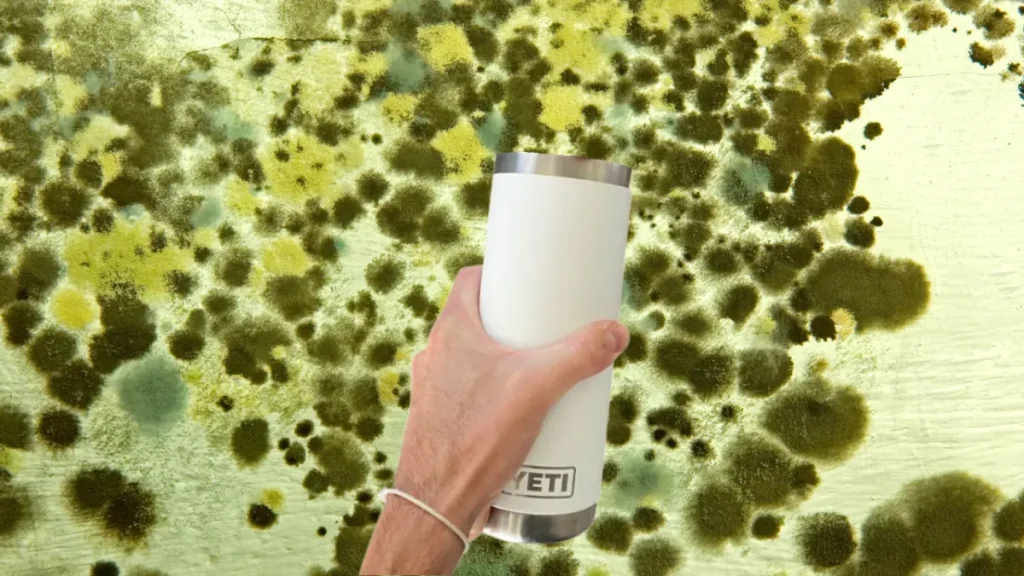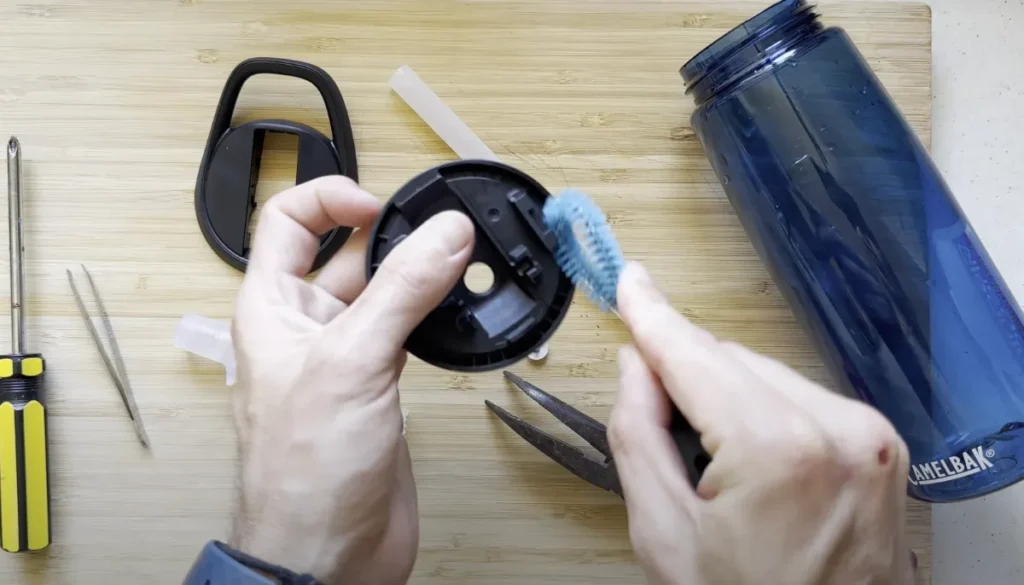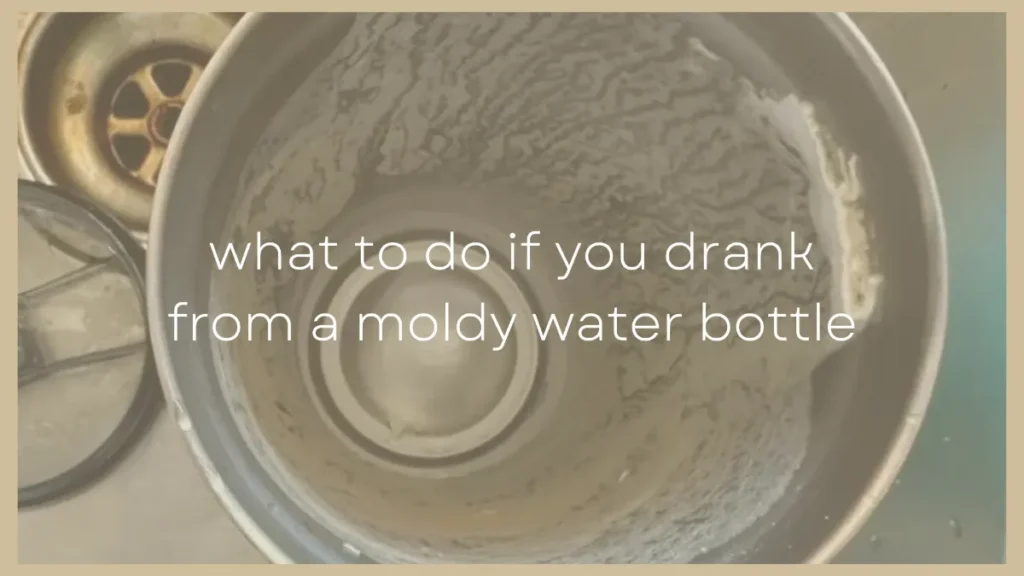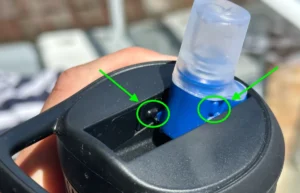Mold isn’t always visually detectable and you can’t always smell it. This means you might use your water bottle and only notice the mold after you've already drunk from it.
Is this dangerous and what should you do if you've just drunk from a moldy water bottle?
If you drank from a moldy water bottle don't panic. While drinking mold isn't healthy symptoms usually aren't severe for short term exposure/consumption. Monitor yourself for allergy or digestive symptoms and make sure to clean and treat you bottle and lid for mold before drinking from it again.
If your bottle is particularly bad then you may want to discard it and buy a new one, but often it's possible to treat and kill the mold and then keep using your bottle once it's clean.
Mold can cause a wide range of symptoms in humans and it’s important to take action as soon as you notice signs of mold.
But I also found it helpful to know that mold exposure doesn't tend to cause extreme symptoms in most people with short term or minimal exposure.
So while drinking a bit of mold isn't good for your health, if you find the mold and stop drinking water with mold in it then most people will recover.
My Water Bottle Has Mold and I Drank from It – What Should I Do?

If you've drunk water from a bottle and only realized after the fact that the water bottle has mold in it then it's normal to be freaked out and maybe a little grossed out.
Maybe you’ve deep cleaned your water bottle and were shocked to discover mold when you dismantled the lid. You could have been drinking water with mold in it for weeks or even months!
If your water bottle has mold and you just drank from it, don’t panic. Short-term mold exposure is unlikely to harm you unless you’re immuno-compromised or have a respiratory condition.
Action to take includes:
- Monitoring yourself for allergy symptoms or digestive issues.
- Stop drinking from the bottle until you've treated and removed all the mold.
- Checking any other water bottles you own for mold and treat them too.
- Deep clean and sanitizing your water bottle and lid.
- Buy a new bottle if your bottle can't be redeemed.
Having mold in your water bottle or tumbler is more common than you think. It's one of the major gasket problems with a lot of bottles. Check the video below to see a doctor talking about one of his patients who had this issue with their Yeti tumbler:
Monitor Yourself for Mold Symptoms
Noticing mold in your bottle isn’t reason to panic because it usually only causes health problems if you’ve been exposed to it for several weeks or months. Also, many mold strains aren’t harmful.
However, it’s still a good idea to monitor yourself for physical symptoms that mold causes and see a doctor if they persist:
- Allergy-type symptoms. If you usually have seasonal allergies, you’re more likely to experience allergy-like symptoms when exposed to mold over the long term. Examples include sneezing, runny nose and itchy skin.
- Respiratory issues. You’re at increased risk of having a severe reaction to mold in your water bottle if you already have a respiratory condition, like asthma or COPD. Mold can make your usual symptoms feel worse.
- Digestive issues. A moldy water bottle can release spores or pieces of mold into the water. Long-term mold exposure can can cause digestive issues, such as diarrhea, vomiting or stomach cramps.
- If you’re immuno-compromised, you may be at increased risk of experiencing severe symptoms from mold expsoure. Children also don’t have fully developed immune systems so close monitoring is essential.
Don’t Drink from Your Water Bottle
Most people don’t have access to lab equipment to determine the mold strain, so there’s no way of knowing if it’s a harmful variety or not.
You can however test your water for mold to find out whether or not you have in fact drunk mold.
That said, it’s best to play it safe and avoid drinking from it until you’ve deep cleaned the bottle and lid.
Check Your Other Water Bottles for Mold
If you have one water bottle with mold, there’s a good chance that your other ones have it as well.
There are some common signs of mold in water bottles, which include the following:
- A white fuzzy film
- Black, dark green or grey spots
- A musty, ammonia-like or earthy smell
- Black or dark slime in the lid
- The interior of your bottle feeling slick or slimey
I shine a flashlight in my opaque and aluminum bottles to check for mold as it’s difficult to detect it with the naked eye.
But if I'm concerned I'll treat my water bottles for mold even if they don't have any obvious signs of mold. It's better to be safe than sorry right?
Deep Clean Your Water Bottle
Deep cleaning your water bottle will remove mold from it, making it safe to drink from again.
Here’s how I normally do it:
1. Empty the bottle and clean it with hot water and dish soap. You can also use a bottle cleaning tablet (like the great ones I get from Amazon) but I find that hand washing is more effective when I'm doing a deep clean.
The idea here to to remove any obvious mold build ups so when you treat the bottle with a mold killer it gets everything remaining that you can't easily remove.

2. Clean the lid. If you have a bottle with a spout or any sort of complex lid, you may need to dismantle the lid first.
A lot of the popular water bottles these days like CamelBak and Contigo have complex lids that can hide mold inside the lid where you can't see them or easily reach them. To clean these lids you actually need to completely pull apart the lid.
If you don’t know how to do this, check out my article where I show you how to take apart a Camelbak Eddy lid (I have guides for other water bottles on my website as well).
3. Sanitize the bottle and lid – treating and killing the mold. The next and most important step is to actually treat the bottle with something that kills mold. Warm soapy water or throwing your bottle in the dishwasher is NOT enough.
I like to use white vinegar because it's a naturally mold killer it isn’t as harsh as bleach but disinfects my bottle just as effectively. I soak my bottle and the lid parts in white vinegar for 30-60 minutes or even overnight if my bottle has been especially bad.
4. Allow the bottle and lid to dry completely before reassembling. This is important because the last thing you want is more mold growing in the parts that are still wet.
5. Store your bottle with the lid off. Once dry you want to make sure you store the bottle with the lid off so more mold can't grow
6. Check your bottle for mold regularly. Make sure to clean your bottle after each use (like you would any glass your drank from) and give it a deep clean every couple of weeks or at least once a month, or more often if you use anything other than water in your bottle.
Buy a New Water Bottle or Lid
If you have a good quality water bottle (like a Nalgene or Hydro Flask) it can feel like a shame to have to throw it away. However, if the infestation is severe, you might still feel uncomfortable drinking from it.
You can remove mold from a Nalgene or most other water bottles, but sometimes the lids get beyond saving and should just be thrown out.
In this case, buying a new water bottle is your best bet. If you’re on a tight budget, you could also replace the lid only as this is where most of the mold usually is.
If your bottle is quite old, now might be a great time to invest in a new one.




